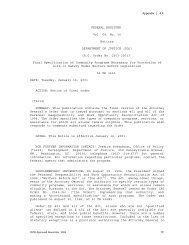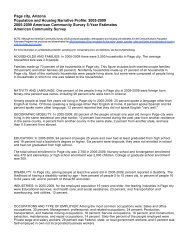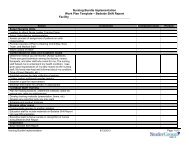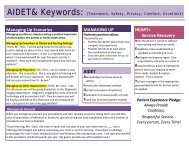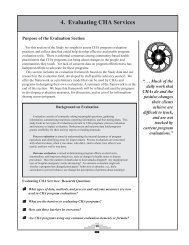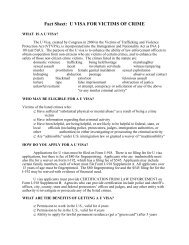Arizona Rural Health Clinic Designation Manual - Arizona Center for ...
Arizona Rural Health Clinic Designation Manual - Arizona Center for ...
Arizona Rural Health Clinic Designation Manual - Arizona Center for ...
Create successful ePaper yourself
Turn your PDF publications into a flip-book with our unique Google optimized e-Paper software.
B. Interpretive Guidelines <strong>for</strong> <strong>Rural</strong> <strong>Health</strong> <strong>Clinic</strong>s (con’t)<br />
require the clinic to make temporary arrangements <strong>for</strong> medical direction with another physician(s), and this<br />
might alter the scheduled times the physician is present in the clinic. Follow these situations closely, and<br />
make recommendations about approvals pending correction of defi ciencies, compliance, or decertifi cation.<br />
It in the responsibility of the clinic to promptly advise you of any changes in staffi ng which would affect its<br />
certifi cation status.<br />
B. Staffi ng Availability. A physician, nurse practitioner, certifi ed nurse-midwife (meeting the defi nition in<br />
42 CFR 405.2401(b)(10)) or physician assistant must be available to furnish patient care services at all<br />
times the clinic operates. Only the scheduled operating hours the clinic is offerring RHC services are to be<br />
considered (as distinguished from other ambulatory services or related health activities).<br />
A nurse practitioner, certifi ed nurse-midwife or physician assistant must be available to furnish patient care<br />
services at least 50 percent of the scheduled operating hours during which RHC services are offered, even<br />
though a physician is present in the clinic on a full-time basis during the time RHC services are offered. The<br />
phrase “available to furnish patient care services” means (1) providing RHC services in the clinic; (2) being<br />
physically present in the clinic even though not providing RHC services; or (3) providing RHC services to<br />
clinic patients outside the clinic. These services must be RHC services. Items (1) and (2) indicate that a<br />
physician, physician assistant, certifi ed nurse-midwife or nurse practitioner is present on the premises, not<br />
on call, during the scheduled operating hours when RHC services are offered at the facility. Item (3) refers<br />
to that part of the clinic’s operating schedule utilized in providing RHC services outside the clinic.<br />
A RHC’s total operating schedule, there<strong>for</strong>e, consists of offering RHC services at the clinic, as well as<br />
providing RHC services to patients outside the clinic. Determinants of how a clinic schedules its operating<br />
time include the size of the required staff, patient population, and where the services need to be provided.<br />
Some clinics, within their scheduled hours, may be able to concurrently offer RHC services both on and off<br />
the clinic’s premises, whereas other clinics may have to schedule separate hours <strong>for</strong> offering the services<br />
on and off the clinic’s premises (e.g., a clinic’s total operating schedule may be from 9 a.m. to 5 p.m. daily,<br />
with on-premises services offered from 9 a.m. to 3 p.m., and off-premises services offered from 3 p.m. to<br />
5 P.M.).<br />
Section 1861(aa)(2)(J) of the Act requires that a physician assistant, certifi ed nurse-midwife or nurse<br />
practitioner must be available to provide patient care services during at least 50 percent of the RHC’s<br />
total operating schedule. There<strong>for</strong>e, a physician must provide needed services at other times during the<br />
clinic’s scheduled operating hours. A RHC which does not have a physician, physician assistant, certifi ed<br />
nurse-midwife or nurse practitioner on the premises to render services during the scheduled operating<br />
hours of the clinic does not meet the requirements of S1861(aa)(2) of-the Act, even though the 50 percent<br />
requirement may be met.<br />
The following are examples of how determinations regarding these requirements may be made. A clinic has<br />
a total operating schedule of from 9 to 5 Monday through Friday, and from 9 to 1 on Saturday (44 hours a<br />
week). RHC services are offered from 10 to 5 Tuesday through Friday (28 hours a week, which satisfi es the<br />
51 percent requirement). A physician, nurse practitioner, certifi ed nurse-midwife, or a physician assistant<br />
must be available to furnish patient care services from 10 to 5 Tuesday through Friday (28 hours a week).<br />
Of these 28 hours, a nurse practitioner, certifi ed nurse-midwife or physician assistant must be available at<br />
least 14 hours (5.0 percent of 28 hours) to furnish patient care services.<br />
In some cases, the clinic’s weekly schedule may not be a logical period of time on which to base these<br />
determinations, and consideration of the biweekly or even a monthly schedule may be more appropriate.<br />
Such a situation may occur when a clinic has a very limited total operating schedule and the schedule<br />
offering RHC services is concentrated in a specifi ed period of the biweekly or monthly total, schedule.<br />
An example would be a clinic that is open only every other Tuesday and Friday from 10 to 4 (24 hours a<br />
month), and RHC services are offered every other Tuesday from 10 to 4, and one Friday a month from 10<br />
21



